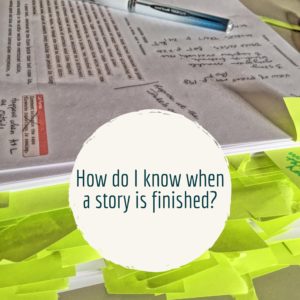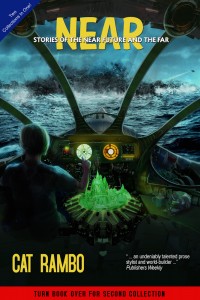 Yesterday I taught a day-long workshop on rewriting and editing one’s work for Clarion West. I usually do this as a two hour online workshop, so it was interesting to take the class and get a chance to really flesh it out, particularly since I can use this version to create an on-demand version.
Yesterday I taught a day-long workshop on rewriting and editing one’s work for Clarion West. I usually do this as a two hour online workshop, so it was interesting to take the class and get a chance to really flesh it out, particularly since I can use this version to create an on-demand version.
As with all writing advice, mileage will vary according to the individual. The best thing as a writer that you can do is to pay attention to your own process and make it more effective. Experiment with lots of things, identify the practices that work, and incorporate them into your process. Keep experimenting, mixing things up a little, every once in a while, writing to the sound of whale songs, or dictating while hiking, or using a pen rather than the keyboard — it doesn’t matter what as long as you keep testing things in a way that lets you grow as a writer.
The Revision Process is Not One-Size-Fits-All
In thinking about revision, one has to acknowledge that some things really affect the process in a way that makes it vary from author to author, such as:
- The length of the piece. A novel is a much different thing than a story, and one of the basic differences is that you (or at least in my experience) can hold the entirety of a story in your head in a way that you cannot with a novel. Novels are also more complicated, usually involving multiple storylines and subplots in a way stories cannot, which adds extra steps. In this piece, I’m focusing on short story, but I’ve got an additional list of considerations when working with novel length stuff that I’ll cover in the online version, which should go up in the Rambo Academy at the beginning of December.
- Whether the writer’s rewrite process focuses on subtracting or accreting. In my experience the majority of writers overwrite, and the focus of the revision process is trimming away excess. But some folks are accreters, by which I mean their process is one of adding and fleshing out. This definitely affects the revision process.
- Where you lie on the outliner vs. pantser continuum. Do you write out a 30 page outline before you begin writing or do you sit down and see where the words take you? My theory is that the amount of overall work a writer does is invariable; some writers do it beforehand and others do it afterwards while revising. The more outlining and prep work work that happens beforehand, the less will (usually) be necessary in the revision stage.
- Some stories simply need less work than others.
 How to Know When You Are Done Revising
How to Know When You Are Done Revising
This is the question that comes up more than any other: how do I know when a piece is ready? The way I do it is by breaking down revision into a three stage process. When you finish the last step, start sending it off, and don’t revise between submissions (unless someone gives you amazing advice). Figure out 3-5 markets and as soon as it comes back from one, send it to the next.
Here are the stages of revision. Before you start them, you must a) have a first draft and b) set that draft aside to cool for a while. Stephen King suggests putting a novel aside until you no longer think about it on a daily basis. With a short story, give it at least a week, preferably two.
And that first draft can be terrible. Really. You’ll be able to fix it. The first draft is just you flailing around. That’s perfectly natural. You throw words, sentences, paragraphs and scenes onto the page, perhaps in the order that they will stay in, perhaps in a totally different assemblage. That’s okay. You have the words.
Stage I of the Revision Process: This is where you figure out your plan of attack. Read through, with a notebook handy for jotting stuff down if it occurs to you but mainly focusing on the manuscript. Keep track of holes, scenes that still need to be written, as well as major changes. I print out a copy and I write all over it; append things, scratch things out, move pages from here to there.
Focus on big ticket items, things that affect the manuscript at the top level: moving scenes around, changing POV or verb tense. Making sure that the chronology is correct, particularly when working with multiple view points. Think about the characters.
Are they likable – do the reader have some point of identification with them? It can be something very small, such as showing them taking care of something like a pet or plant. Are their motivations clear? Do you know what they want, what’s keeping them from getting it, and how they plan to change that situation? Do you have some sense of their history before they entered the piece, and how can you reflect that in the piece? Where can/should you go more deeply into their head?
What’s the overall story arc? What’s the human experience at the heart of the work; what’s it trying to say about being an intelligent self-aware entity? What promises are you making to the reader and where don’t you live up to them? Where can you make things clearer for the reader? Are there missing scenes? If so, write them now.
What’s the pacing like; are you moving the story along in a smooth flow that pulls the reader in? If not, where are you failing to do so?
 What’s the world like? How can you keep it from being generic? What details does your reader need to know and where have you forgotten to supply such information? How does the world feed into the theme of your story? Where are the cool eyeball kicks and nifty things that will entertain your reader?
What’s the world like? How can you keep it from being generic? What details does your reader need to know and where have you forgotten to supply such information? How does the world feed into the theme of your story? Where are the cool eyeball kicks and nifty things that will entertain your reader?
Don’t fix things about the style or other sentence level considerations, but keep a list of these that you’ll be able to address in a later stage.
Stage II of the Revision Process: You marked all over the printout, making changes and then incorporated them. Here I print out a fresh copy, because unfortunately my process is not particularly eco-conscious.
Now you’re looking at a finer level than the first pass. Stage I was coarse sandpaper; now you’re moving to a finer grade. This is the point where I look hard at paragraphing, splitting up overly long paragraphs, using single sentence paragraphs for an occasional punch, and making sure the first and last paragraph of every scene works, creating a transition that doesn’t allow the reader to escape the story.
I have an unfortunate propensity for scattering scene breaks through my work; this is the place where I remove a lot of them, because I know that every time one occurs, it bumps the reader out of the story and reminds them that they’re reading. I also remove a lot of unnecessary speech tags at this point. I make sure the speaker is identified every third or fourth speech act in two people dialogue so the reader never has to count back in order to figure out who is talking at any point.
I’m also looking at sentence length. Here is an exercise that may be useful: take a page of your prose and go through counting how many words are in each sentence. If they are all around the same length, it creates a sense of monotony. Split things up. Short sentences have punch; long sentences full of polysyllabic words create a languorous, dreamy feel that may be desirable to your narrative yet radically slows things down on the page. (Did you catch what I did there?)
Stage III of the Revision Process: Once again, edits are made on the computer and printed out. Time for your very finest grade of sandpaper, the last few passes. In this, I rely heavily on Ken Rand’s excellent little book The 10% Solution, which I cannot recommend heartily enough. This is the point where you pick up individual sentences and tap them to make sure they ring true.
Above all this is the stage where you read aloud. If you do not read your work out loud and you take only one thing away from this essay, please make it starting to read your stuff out loud. You will catch errors and repeated words. More importantly, you will catch infelicities and ungraceful sounds.
And this is how you know you are done. Once you have done this once, perhaps more depending on your degree of perfectionism, the story is ready to have a cover letter attached and to go out into the world. Celebrate briefly, then go work on a new piece.
Learning to Trust Yourself as an Editor
Part of being a writer is the act of writing, letting the words flow out onto the page. It’s a joyful part when the words are coming fast and quick and wonderful.
Another part is the act of rewriting, taking the results of that flow and turning them into a wonderful writing. If you know that you can do this, it helps with the act of writing, because you’re not worrying about whether what you’re writing is good or not. You know that what matters is producing the words, because you can trust yourself to make them better.
If you have a lump of words, you can always turn them into something, even if it takes resorting to outrageously and wonderfully experimental techniques like a cut-up in the mode of William S. Burroughs. With a blank page, your options are considerably more limited.
Once you learn to trust your editing skills, worrying about the writing’s quality will not impede the flow — at least as much, given that we are all a bit insecure. Think of trapeze artists – if you can trust the safety net that editing will provide you, you will be able to take the risks necessary to learn how to execute amazing aerial maneuvers in your writing.
How do you learn to trust yourself as an editor?
- Read widely both in and out of the field, and read at least one classic for every piece of trash.
- Read what people say about the field and writing in general. Are there writers you like? They may well have written about their process, which you can usually find via their website.
- Look at what people do in their writing and how they do it. Here are some books I recommend: Carol Bly’s The Passionate Accurate Story, Dave Farland’s Million Dollar Outlines, Stephen King’s On Writing, Ursula K. LeGuin’s Steering the Craft, Shawl and Ward’s Writing the Other, Phyllis Whitney’s Guide to Fiction Writing, Kate Wilhelm’s Storyteller. Want to go deeper than that? Try Wayne Booth’s The Rhetoric of Fiction, Samuel R. Delany’s About Writing, Hoffman and Murphy’s Essentials of the Theory of Fiction, Michael Moorcock’s Wizardry and Wild Romance, Jeff Vandermeer’s Wonderbook, or Williams’ Style: Lessons in Clarity and Grace.
- Have some notion in your head of what writing is supposed to do. Teaching classes is a pretty good way to acquire this. So is thinking hard about it and writing essays. One of the best essays I know on the subject is George Orwell’s “Politics and the English Language.â€
Your Writing Group and the Revision Process
Your writing group — or your group of beta readers — is a huge asset when working with a piece. You will want different kinds of feedback from them depending on what stage the manuscript is at, so let them know: are you looking at the big picture or is the piece about to go out and you just need copyedits and minor tweaks.
You do not have to take every piece of feedback that is given you, particularly if you don’t think the person understood what you were trying to do with the story. I have found that if everyone is pointing to the same thing about a story, it is indeed broken at that spot, but usually none of the suggested fixes will work and I will need to go off, think hard about it, and come up with something that works.
I feel that one learns more from critiquing than by being critiqued, overall, and so participating in a writing group is part of that learning to trust your internal editor.
Letting Go
Sending a story out into the world can be hard, particularly if you’re not sure that it’s ready. But you must. Sending pieces out and getting feedback, even when it’s a simple yes/no, is part of being a writer. Stories sitting on your hard drive do no one any good, particularly you. Good luck!
#sfwapro





